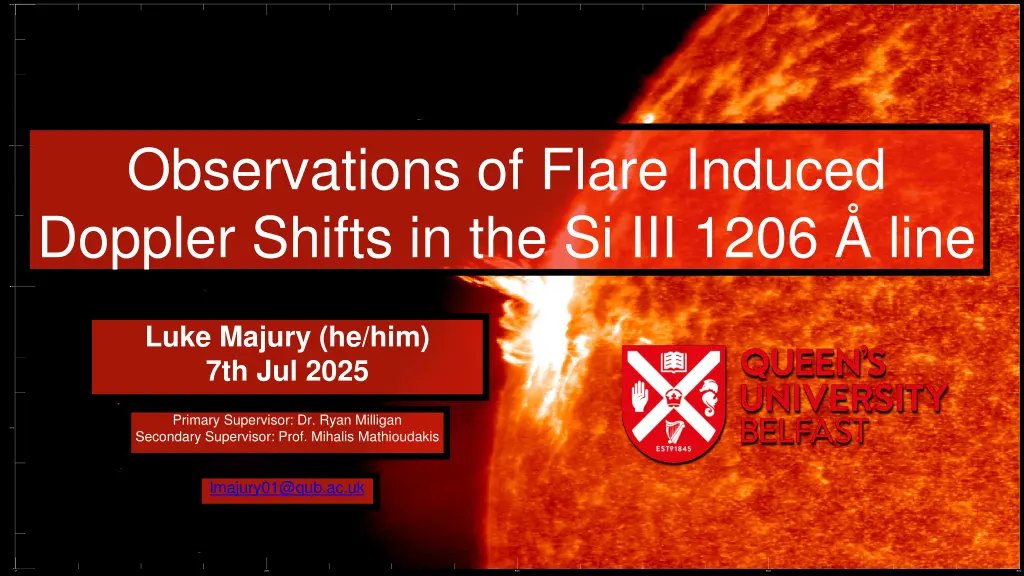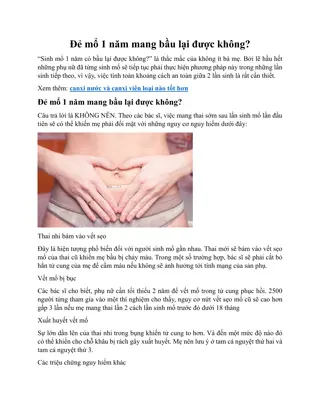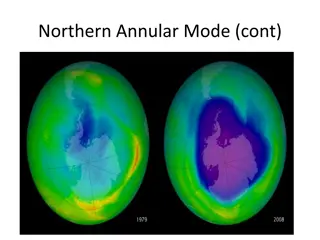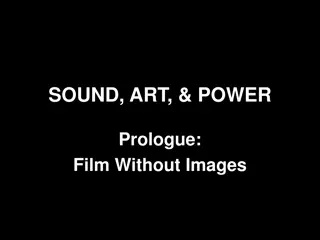
Flare-Induced Doppler Shifts in Si III Line
Explore observations of Doppler shifts in the Si III 1206 line during solar flares, investigating various processes affecting spectral lines and analyzing data from SORCE/SOLSTICE spacecraft. The study highlights the potential diagnostic value of Si III line shifts in understanding mass motions and spacecraft-related effects on observations.
Download Presentation

Please find below an Image/Link to download the presentation.
The content on the website is provided AS IS for your information and personal use only. It may not be sold, licensed, or shared on other websites without obtaining consent from the author. If you encounter any issues during the download, it is possible that the publisher has removed the file from their server.
You are allowed to download the files provided on this website for personal or commercial use, subject to the condition that they are used lawfully. All files are the property of their respective owners.
The content on the website is provided AS IS for your information and personal use only. It may not be sold, licensed, or shared on other websites without obtaining consent from the author.
E N D
Presentation Transcript
Observations of Flare Induced Doppler Shifts in the Si III 1206 line Luke Majury (he/him) 7th Jul 2025 Primary Supervisor: Dr. Ryan Milligan Secondary Supervisor: Prof. Mihalis Mathioudakis lmajury01@qub.ac.uk
Observations of Doppler Shifts During Flares 2 Doppler shifts in spectral lines are commonly used to infer chromospheric condensation and/or evaporation However, other processes such as filament eruptions and jets may contribute to observed shifts (Batchelor and Hindsley. 1991.) Spectrally resolved observations of lines at understudied temperatures offer an opportunity to further disentangle these effects Doppler velocities of lines observed by HINODE/EIS during a flare (Milligan et al. 2009.)
3 SORCE/SOLSTICE Primarily provided low cadence observations of FUV/MUV spectral irradiance Ly? Nominal scans provided profiles (1203-1227 ) at cadence of ~one minute Si III Captured 129 flares of GOES C-class or greater OV Previous SOLSTICE flare studies focus on Ly? emission but note significant enhancement of Si III line (e.g. Woods et al. 2004. Milligan et al. 2016. Majury et al. 2025)
4 Si III line During Flares Number of flares in SOLSTICE catalogue show drastic shifts in Si III line Line may offer novel diagnostic of mass motions at T = 104.6K
SOSLTICE Rastering Effects 5 SOLSTICE nominal scans were taken in 1 second steps, rastering across the Ly? and Si III lines Introduces potential artificial shifts/asymmetries into observations
6 Spacecraft Manoeuvres SOLSTICE spacecraft manoeuvres cause a shift in absolute position of wavelength grid Relationship between magnitude of shift and manoeuvres not well characterised Thus cannot rule out systematic influence on shifts for flares coincident with manoeuvres
7 Sample Selection 29 events that had >10% enhancement relative to first scan chosen Omitted events with spacecraft manoeuvre interference Set of 11 events chosen for analysis of Doppler shifts
8 Si III Doppler Analysis Quiet-Sun profile defined as average of >3 scans before or after GOES flare duration without interruption by spacecraft manoeuvre Flare profile defined as profile with greatest enhancement over QS Slow drift in SOLSTICE wavelength grid's absolute position (~15 km s 1 over scan) Corrected by rebinning quiet-Sun wavelength grid to that of flare profile
9 Si III Doppler Analysis Quiet-Sun-subtracted `flare profile' calculated Change in centroid position relative to quiet-Sun profile determined Doppler velocity of `flare profile' determined using classical Doppler formula
10 Si III Doppler Analysis Five events showed blueshifts, four showed redshifts, two had no significant shift (<3?) No apparent tendency towards either shift direction Remarkably high velocities (between -118 and +131 km s 1) seen Shifts remain consistent across multiple scans => rastering effects likely not responsible
11 Si III Doppler Analysis See filament eruption during C8.4 that coincides with shift in profile May indicate that bright emission from filament drove the observed blueshift (Rubio Da Costa et al. 2009. Wauters et al. 2023. Majury et al. 2025.) Further imaging observations required to verify whether eruptions are cause of blueshifted velocities
12 Conclusions Si III line shows both blue and red Doppler shifts in a sample of flares C-class and above, providing a novel flare diagnostic at transition region temperatures Both unusually fast upflow (45-118 km s 1) and downflow velocities (68-131 km s 1) seen Fast upflow velocities in sample may be driven by emission from (failed) filament eruptions Downflow velocities exceed maximum expected values given VAL-C atmosphere (~80 km s 1 in F-CHROMA models), likely requires underdense starting chromosphere possibly driven by mass ejection from jets or eruptions before flare onset Results of study recently submitted to Sol. Phys. ! Majury et. al. 2025b.
13 Future Work Si III line may serve to provide constraint on radiative hydrodynamic flare simulations (e.g. RADYN) which have been investigated for other Si transitions (Kerr et al. 2019.) High contrast of the Si III line during flares may make it particularly useful in observations of weak flares from upcoming instruments such as SOLAR-C/EUVST and SNIFS, especially in combination with observations of other lines and by other instruments (e.g. MUSE, EIS, IRIS)
14 END
15 Contribution of Filaments to Flare Irradiance Filaments contributed ~18% of total flare excess during impulsive phase of 10 M- and X-class events May potentially explain fast blueshift velocities, can see filament eruptions at over 100km s 1 (Zhang et al. 2015.)
16 Si III Line A number of events in the SOLSTICE flare list show large Doppler-velocities in Si III, indicative of chromospheric evaporation and/or condensation
17 Si III Line
18 Si III Line
19 Si III Line Past research shows similarly chromospheric lines (He II, Si IV) to have much smaller line shifts during flares (Milligan & Dennis 2009, Sellers et al. 2022) Further research required to reveal underlying cause






















